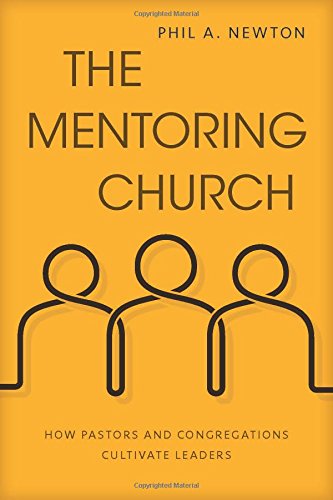A Book Review from Books At a Glance
By Micah McCormick
There is a lot of discussion these days about church leadership. On the one hand, that’s a good thing. The Bible speaks about the significance and influence of leaders in the church, and Scripture gives clear instruction about the expected character and activity of church leaders. The other side of the fascination with church leadership, however, is a fascination with charisma and personality and force of will. When it comes to discussing what kind of leader a pastor should be, books dot the whole spectrum, with some books focusing more on pastor as CEO brand director and some focusing more on pastor as personal shepherd. But while writers continue to debate what kind of pastor is the best model, not as many books deal with subject of training leaders (although of course if you’re going to train leaders you normally have some type of model in mind).
Enter The Mentoring Church, by Phil Newton. Newton seeks to “consider the biblical and theological foundation for local churches and pastoral leaders training those that the Lord raises up from among them for gospel ministry” (p.16). The book progresses over fourteen chapters, but it could easily be split up into three major sections: 1) Mentoring Models in the Bible; 2) Mentoring Models in Church History; 3) Mentoring Models Today.
One of the great strengths of this book is that Newton highlights the importance of in the flesh, life on life mentoring. He laments the limitations of “content-driven training such as found in seminary classrooms, lectures, or conferences” (p.33). This is not to say that there is no place for such information download, and certainly as Newtown unpacks the biblical data, mentoring will involve verbal teaching. But Bible colleges and seminaries provide a supplement that serves best in partnership with the local church, not in place of the local church. Indeed, Newton dedicates the book to the church planters, missionaries, pastors, elders, and church leaders who have been mentored at a specific church, his own church of South Woods Baptist.
Newton goes one step further. He doesn’t merely highlight the importance of one-on-one mentoring from active ministers to aspiring ministers in the local church, he draws out the importance of the gathered congregation—also dedicating his book to the congregation that has facilitated such mentoring. Mentoring takes place best in a church community. An aspiring elder might not spend equal time with every single individual in his church, but he can’t help but be shaped by the whole life of the body. Sometimes as much is caught as taught, as the adage goes. Newton has a whole chapter on “mentoring communities” in Scripture, pointing out that Christianity blossomed in the Jerusalem church (p.43) and that the church of Antioch sent out Barnabas and Saul (p.50).
This book also provides an antidote for the common sentiment that human culture has changed radically from the culture of the New Testament, so we shouldn’t expect an exemplary pattern of mentoring that can still hold up hundreds of years beyond the close of the canon. Newton draws extensively from training models from time periods as diverse as Calvin’s Geneva (p.87ff) and Bonhoeffer’s Germany (p.108ff). The biblical pattern may not afford a cookie cutter approach that will look exactly the same in every context, but the general principles hold true, and it is remarkable how effective a simple and biblical model of training has proven to be in so many diverse settings. Newton brings his historical tour all the way into the present time, considering The Summit Church in North Carolina (p.178ff) and Capitol Hill Baptist Church (p.143ff), among others.
One of the weaknesses of the book stems from a strength. Newton shows time and time again how the patterns and principles of biblical leadership development are replicated in setting after setting. This evidence drives home the point to the reader, but it also makes for a lot of repetition. I mean a lot of repetition. Did I mention there is a lot of repetition in this book?
One other minor weaknesses in the book is that at times Newton seems to pit “organic” types of development over against “institutional” development (p.20). But when Jesus promised to build his church, he gave it an institutional structure and authority. There are keys and discipline and officers and insiders and outsiders. There is binding and loosing and rejecting and receiving. It’s not a cold and distant bureaucracy, and perhaps that’s all that Newton intends to reject. But a clearer conception of the church as an organic institution or family business (or whatever expression you want to use) would be helpful in showing just why it is that a church community should take priority over a college campus ministry community.
On the whole, this book is a rich resource for a renewed call to a simple, ancient, and Christ sanctified form of mentoring. The Mentoring Church might be most useful as a kind of reference manual, where readers can scan from chapter to chapter depending on whether or not they are looking for a reminder of what Paul did or what Spurgeon did. And the book itself provides an excellent appendix of further works to consider on the subject of pastoral training. So take up and read!
Micah McCormick (PhD) is Assistant Pastor at New Hyde Park Baptist Church in New Hyde Park, NY.
Buy the books

The Mentoring Church: How Pastors and Congregations Cultivate Leaders